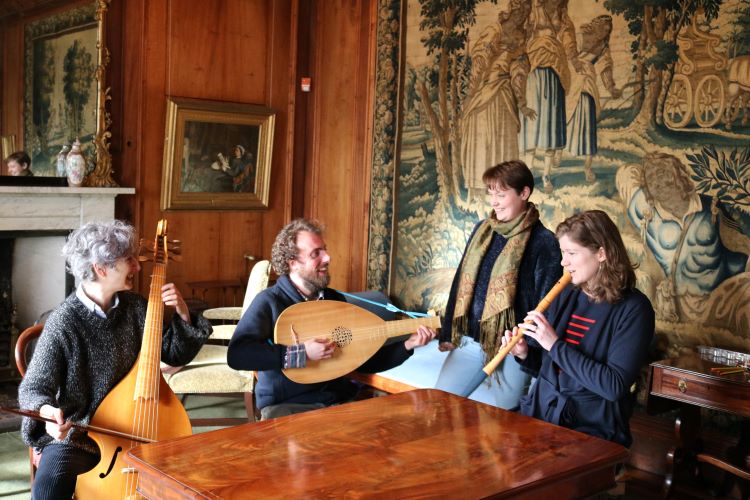Editor: The Spinacino Consort is based in Scotland, and its performances draw on careful research about the early modern song and instrument culture of Scotland. Soundyngs says, listen, enjoy, learn.
- Online Concert – Spinacino Consort: ‘Away Vain Warld’ – The Music of Elizabeth Melville
Tickets to this concert can be purchased here.
A selection of individual tracks can be seen in the resources below.
Spinocino’s next live concert is on the 7.30pm, 1st April, 2023, George Watson’s College, Colinton Road, Edinburgh EH10 5EG, as part of the Society of Recorder Players Annual Festival.
Eric Thomas, lutenist and founder of the group, writes as follows:
On the 1st February the Spinacino Consort will release an online concert ‘Away Vain Warld’ – The Poetry of Elizabeth Melville. Filmed last year during the Edinburgh Fringe Festival, and kindly supported by a Continuo Foundation grant, this concert takes the sacred contrafacta* of Elizabeth Melville as a springboard to explore the music of sixteenth- and early seventeenth-century Scotland.
Women in the early modern period often wrote for private circles but it was unusual for their work to reach a wider public readership. Elizabeth Melville, Lady Culross (c1578-1640) was a female poet who, unusually, saw at least some of her poetry (the Calvinist work Ane Godlie Dreame) reach a larger audience in print format. In addition, a large volume of her work survives in hand-written manuscripts. Although Calvinists might popularly be supposed to be music-averse, Spinocino’s performances show that many post-Reformation Scots – including Lady Elizabeth – clearly loved singing.
Uncovered in the Bruce manuscript by Dr Jamie Reid-Baxter, Melville wrote lyrics for five sacred parodies using popular English, Scottish, and French tunes, here performed as songs in versions inspired by music from Renaissance Scotland. Recent research by violinist and Aberdeen University lecturer Aaron McGregor places the introduction of the violin to Scotland much earlier than previously thought; Spinocino is therefore performing this music using a broken consort* of violin, lute and viol.
Scotland’s musical culture connected Scottish indigenous music with French court culture and English music; Scots in this period as in others would have heard an international repertoire. In their most recent performances, the Spinacino Consort play chansons by French court composer Claudin de Sermisy, intabulated* by lutenist to Mary Queen of Scots Jean-Paul Paladin, alongside contemporary Scottish and English lute song and consort music, and folk music found in the first Scottish lute manuscripts, the earliest notated sources of this music. Spinacino’s work this year includes several modern premieres, including Sermisy’s ‘Vouz perdez temps’ originally thought to be by Jacques Arcadelt; the version of John Dowland’s ‘Lachrimae’ to be found in the Thomas Wode partbooks; and the setting of ‘Joy to the Person of my Love’ from the Robert Taitt manuscript. Taitt – a 17th century school teacher, session clerk and musician – shows that the post-Reformation church of Scotland had space for music lovers.
Glossary:
*broken consort: a Renaissance ‘consort’ normally uses a set of instruments of different sizes but of the same sort (e.g. all viols, all recorders, etc); a ‘broken’ consort mixes instruments from different families.
*contrafacta: songs that set new text to pre-existing music
*intabulation: conventional written scores use clefs and dots on lines and spaces. Lute and guitar ‘tabulation’ uses a method that shows on the lines and spaces which strings and fingers to use on these instruments. There are different ways of doing this – e.g. French, Spanish etc.
Further Resources:
Spinacino website
Spinacino Youtube Recordings from Greyfriars Kirk, Edinburgh Fringe Festival, August 2022:
- “Ane Godlie Song” with lyrics by Elizabeth Melville
- “My Lord of Marche Pavane and Hutchinson’s Galliard” by James Lauder and Anon.
- “Vous Perdez Temps” by Claudin de Sermisy
- “Joy to the Person” and “Adew Dundee”
Reading Suggestions
- Sarah M. Dunnigan, “Sacred Afterlives: Mary, Queen of Scots, Elizabeth Melville and the Politics of Sanctity.” Women’s Writing 10(3) (2003), 401–24.
- Theo van Heijnsbergen, “Amphibious Lyric: Literature, Music and Dry Land in Early-Modern Verse” in Notis Musycall: Essays in Honour of Kenneth Elliot, ed. Gordon Munro (Glasgow: Musica Scotica Trust, 2005)
- Nathan C J Hood, “Metrical Psalm-Singing and Emotion in Scottish Protestant Affective Piety, 1560-1650.” Reformation & Renaissance Review 23(2) (2021), 151–69
- Aaron McGregor, “Violinists and Violin Music in Scotland, 1550-1750”, PhD Thesis (University of Glasgow, 2019)
- Elizabeth Melville, Poems of Elizabeth Melville, Lady Culross: Unpublished Work from Manuscript and ’Ane Godlie Dreame’ ed. Jamie Reid Baxter (Edinburgh: Solsequium, 2010)
- Elizabeth Melville, Ane godlie dreame, compylit in Scottish meter be M.M. gentlevvoman in Culros, at the requeist of her freindes (Edinburgh: Printed be Robert Charteris, 1603) – EEBO digital copy from the University of Michigan
- Roslyn Potter, “John Forbes’s Songs and Fancies and Its Literary Legacy”, MPhil thesis (University of Glasgow, 2022)
- Sarah C. E. Ross, “Peripatetic Poems: Sites of Production and Routes of Exchange in Elizabeth Melville’s Scotland.” Women’s Writing 26, no. 1 (2019): 53–70
- Robert Taitt, Book of Music, Songs and Poems c1679-1689- manuscript, held by the UCLA Williams Andrews Clark Memorial Library ref MS.1959.003 ARKark:/21198/zz002b3013

